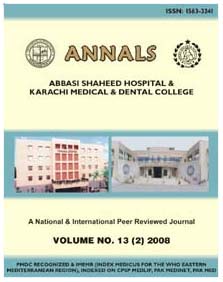
| |
| Home |
| Editorial Staff |
| Instruction to Authors |
| Journal-Issues |
| Policy |
| Copyright |
| THROMBOMODULIN, A PROTECTIVE MARKER AGAINST CORONARY ARTERY DISEASE
1MUHAMMAD AKBAR MUGHAL, 2ABDUL SHAKOOR MEMON, 3BASHIR HANIF, 4NARGIS ANJUM ABSTRACT Objectives: (1)
To compare the serum thrombomodulin levels between apparently healthy
subjects and patients with myocardial infarction and unstable angina
& (2) To assess, whether it may be identified as a protective marker
for determining the incidence of coronary artery disease
|
For
Full text contact to:
|
1 Department of Physiology, Karachi Medical & Dental College & Abbasi Shaheed Hospital, Karachi.
|

Copyright © 2009 Abbbas Shaheed Hospital and Karachi Medical & Dental College.
All rights reserved.
Designed & Developed by: Creative Designers